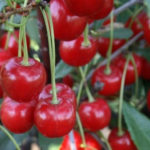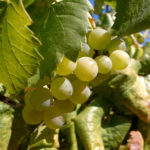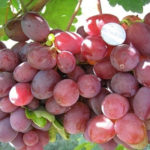Raspberry variety Peresvet
Medium-late raspberry Peresvet is one of the popular varieties of this culture among gardeners and is included in the famous "golden series" of varieties bred by the famous Russian researcher, academician of the Russian Academy of Agricultural Sciences, Honored Scientist of the Russian Federation Ivan Kazakov. Over the decades of hard work, this scientist has achieved amazing results, giving birth to many unique forms of raspberries. At the same time, only those of them were included in the "golden series" that, in terms of their combination of qualities, could be called outstanding. In particular, the distinctive features of Peresvet are unpretentious cultivation, high yield, winter hardiness and resistance to fungal diseases. The resulting fruits delight in their size, good taste, transportability and versatility in use. The list of its shortcomings is much shorter, and these include noticeable spine of the shoots, not too intense aroma of berries, weak drought resistance of plants.

The variety was obtained on the basis of the Kokinsky strong point of the All-Russian Selection and Technological Institute of Horticulture and Nursery (VSTISP) located in the Bryansk region. In 1997, the hybrid form was submitted for state variety testing, and, having successfully completed it, in 2000 it was officially recognized as a variety and registered in the State Register of Breeding Achievements of the Russian Federation. In co-authorship with Ivan Vasilievich Kazakov, researchers from the Institute S.D. Aitzhanov and VL. Kulagin. Raspberry varieties Stolichnaya and Solj served as parental forms during hybridization. At present, Peresvet is zoned and recommended for industrial cultivation in the Central Non-Black Earth Region and in the Volga-Vyatka region. However, amateur gardeners have spread it far beyond these areas, in practice proving the high plasticity of plants, and their ability to adapt to various soil and climatic conditions of cultivation.
Agrobiological properties
Shoots have a fairly high vigor. At the same time, they grow upright, providing a compact arrangement of bushes and, accordingly, the possibility of their dense planting. However, despite the apparent strength of the stems, they definitely need support, or the organization of a trellis, because under the weight of the crop, the shoots can bend to the ground. Strong wind can also inflict significant damage to them. It is more convenient to tie one-year-old shoots to one side of the trellis, and two-year-olds to the other. With this approach, the growth of the current year will not create inconveniences during harvesting and removal of fruiting branches.
The activity of the emergence of replacement shoots in plants is moderate. In the first year of life, they are brownish-green and not covered with a waxy coating. After maturation, the color becomes intensely brown. The thorns are evenly spaced along the length of the stems, their size is medium, the color at the base is purple, and the rigidity is high. Bush maintenance and harvesting must therefore be accompanied by precautions. The leaves grow large, usually consisting of three or five simple leaves, collected on medium-length petioles. The distance between the nodes is shortened. The leaf blades are strongly wrinkled, yellowish-green, with intense pigmentation along the veins. Their profile is curved upward or slightly twisted, the shape is oval with a sharpness at the end, the marginal denticles are saw-like. On each shoot, up to 12 or more fruit branches are formed, strewn with flowers and ovaries. They are concentrated mainly in the upper half of the stem, and, due to their relative strength, they do not need a garter. Root offspring appear in moderation, and therefore their removal will not become too laborious, and there will be no shortage of planting material during reproduction.
The Peresvet variety belongs to the traditional varieties of raspberries, bearing fruit on a two-year growth. Flowering and ripening of berries in it occurs rather late. The size of the flowers is medium, the stamens in them are located at the same level with the pistils. During mass flowering, the bushes literally smell sweet, attracting many bees and other insects. The period of onset of removable ripeness falls on July-August, and it is quite extended in time and requires multiple harvests, which is an advantage in the case of amateur cultivation, and a disadvantage for industrial plantings. Harvesting is facilitated by the easy separation of raspberries from the fruit. In general, from each bush per season, if a high level of agricultural technology is provided, up to 3.5 kg of conditioned berries can be obtained. In large areas, productivity also depends on proper care, but planting density also has a significant impact here.
Ripening berries have a blunt-conical, somewhat elongated shape and a dark crimson color due to the high content of anthocyanins. Their size is relatively large, and the average weight ranges from 3-4.2 grams. The adhesion of the drupes to each other is not bad, and the flesh is quite dense, which determines the suitability of the raspberry for long-distance movement and its resistance to mechanical damage. These positive traits are especially appreciated by farmers who cultivate crops for sale, for whom the high presentation of the berries on the counter is of fundamental importance. Peresvet's taste is pleasant, sweet and sour, but the intensity of the aroma of the fruits, unfortunately, does not differ. The sugar content is about 8.2%, the titratable acidity is 1.7-1.8%, the vitamin C content in 100 g of berries is 25-30 mg. Tasting marks are very high - 4.7 points.
The use of the crop can be very diverse. Due to its excellent gastronomic characteristics, it can be excellent for fresh consumption. On the market, berries attract the attention of buyers for their size, dimensional stability and color saturation. In the processed form, the fruits are also delicious, imparting their excellent taste and brightness to the compotes, jams, liqueurs and fruit drinks. Some gardeners also testify to the good ability of the variety to tolerate shock freezing, followed by thawing, not accompanied by a deterioration in the appearance of raspberries. Thus, you can be sure that no matter how plentiful the harvest is, it will not only not be lost, but in any of the processed versions it will show a guaranteed high gastronomic result.
Agrotechnical features
The economic characteristics of Peresvet complement the general positive opinion about it. So, bushes are able to grow equally well on soils of different mechanical composition and level of fertility. They are not afraid of frosts down to minus 26 ° C, and shoots bent to the ground and covered with snow can withstand even more severe cold. The only point to which plants are very sensitive is sufficient moisture supply during the growing season. For this reason, the cultivation of the form in arid regions is possible only if regular and full watering is ensured. With regard to common diseases and pests of raspberries, our hero shows good resistance to fungal pathogens, as well as to raspberry and spider mites. The rest of the plant protection system should be traditional for the crop.
When choosing a place for planting, they try to choose places that are protected from blowing winds by the terrain or various buildings, when it comes to backyard or garden plots. This will allow to keep snow on the raspberry tree in winter, which protects the plants from low temperatures.The soil must be sufficiently moistened, however, excess moisture, leading to dampness or waterlogging, is also not allowed.
Peresvet is cultivated according to the technology traditional for non-repaired varieties, with fruiting on two-year-old shoots, and their subsequent removal. During the growing season, the cleanliness of the row spacings is maintained, the plants are irrigated and fed, the stalks are tied as they grow, and the treatment with the necessary means of protection.








